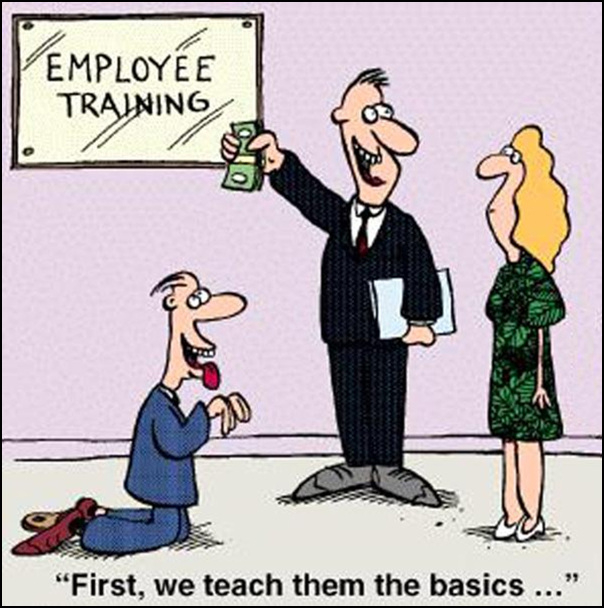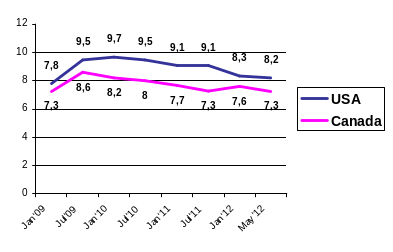
- •Start-up
- •1. These are the names of several academic subjects in business education:
- •2. Relate the following topics to the appropriate subjects from Start-up exercise 1.
- •L eading People and Organisations
- •Vocabulary
- •Qualifiers
- •1. Read the notes from a lecture about good employees. Circle the symbols and abbreviations that are used. Then work with a partner. Take turns making complete statements based on the notes.
- •2. When taking notes, you can use any abbreviations you want as long as your can understand your notes later. Make up your own abbreviations for the following words.
- •1. You will hear a lecture about business management. What are two problems a new manager might have with the employees?
- •Becoming a Leader
- •What do you think of Dale Carnegie’s advice? Would you like to add something?
2. When taking notes, you can use any abbreviations you want as long as your can understand your notes later. Make up your own abbreviations for the following words.
Example: manager – mgr.
a) company __________ d) economy, economic __________
b) business __________ e) important __________
c) government __________ f) employee __________
![]() Listening
Listening
1. You will hear a lecture about business management. What are two problems a new manager might have with the employees?
________________________________________________________________
________________________________________________________________
2. Fill in the blanks with the words from the lecture listed below.
style value underlie benefit stable perspective
responsibilities organise modify vital paradigm accurate
The company treats its employees well and __________ their work.
The manager said the meeting was __________, and we all were required to go.
One of Pam’s __________ is to check her boss’s e-mail.
His poor management __________ caused many problems in the office.
There has been a change in business __________ because of the Internet.
The office was __________ in a new way. This caused some confusion to the employees until they became accustomed to the changes.
I like your __________ on the situation. You have a good understanding of what the issues are.
I need a(n) __________ job. I’ve changed jobs three times in three years!
Valuing employees __________ good management practices.
The company chose the health plan that __________ the employees the most.
We have to __________ the schedule. What do you think we can change?
The manager heard too many different opinions to be able to get a(n) __________ idea of what the employees wanted.
3. The following are verbs from the lecture that can be used with the prefix re-. The prefix re- means ‘again’. It is added to a verb to indicate that something is done again.
Example: “To rethink” (the problem) means “to think about (the problem) again.”
Work with a partner or use your dictionary to check your understanding of these words.
organized modify consider approach gaining
Now read the sentences. Rewrite the sentences, replacing the underlined phrase with re- + the verb in brackets.
Example: The company needed to consider its marketing plan more. (think)
The company needed to rethink its marketing plan.
We arranged the office in a new way again. (organized)
________________________________________________________________
Do you think it is necessary to change the schedule again? (modify)
________________________________________________________________
I guess we need to think more about who will do each task. (consider)
________________________________________________________________
The managers decided they needed to look at the company goals from a new angle. (approach)
________________________________________________________________
The company is getting the team feeling back. (gaining)
________________________________________________________________
Now listen to the lecture and take notes.
4. Use your notes to answer the questions below. For each question, circle the letters of the two best answers.
1) According to the speaker, what is true about current management styles?
a) What the manager says, goes.
b) There is an emphasis on employee relations.
c) There is a focus on team building.
2) What are two reasons given for why team building is important?
a) Employees need to feel valued.
b) Some employees don’t like older managers.
c) Employees need to help each other do their best work.
3) Why was it important for the new manager to meet with the employees?
a) They need time to learn to work harder.
b) It gives them the chance to share their ideas.
c) It tells the employees that their perspectives are important to her.
4) Why does the speaker emphasize the type of questions the manager asks?
a) to show that the manager is focusing on employee relations
b) to show that the manager is focusing on the work itself
c) to focus us on what the manager is like
5 )
What are two important messages that the manager sends to her
employees by making changes after the meeting?
)
What are two important messages that the manager sends to her
employees by making changes after the meeting?
a) She is human and can admit her mistakes.
b) Sometimes change for the sake of change is good.
c) She is in charge but values what they say.
6) What was the manager’s team-building plan based on?
a) having many employee picnics
b) employees sharing perspectives
c) solving problems
5. Decide if these statements are true or false. Correct the false statements.
a) The new manager’s changes made it easier for Mrs. Parks to do her job. T/F
b) In the end, the manager decided the employees jest needed to adjust to the new office organisation. T/F
c) According to the speaker, a good manager should let employees share their perspectives. T/F
d) A strong manager tells each employee what to do. T/F
e) The manager recognises the importance of a stable group of employees. T/F
f) “Do you like the way I treat you?” is an example of a question the manager might ask. T/F
g) Giving employees questions in writing may make it easier for some people to share their ideas. T/F
h) The manager is willing to change the office back to the way it was before because she realises that she may have make some mistakes. T/F
i) The manager believes “change for the sake of change” is always good. T/F
j) The speaker believes that the attitudes about employees and managers reflected in the manager’s plan started in the United States. T/F
![]() Writing
Writing
1. Economic data is often presented in the form of graphs and diagrams (charts). They usually require some comment.
Look at the following chart and then read the text below.
Chart 1: Contribution of main industrial sectors to the percent change in Canada’s GDP, March 2012

Chart 1 (a linear histogram) shows the contribution of main industrial sectors of Canada to the percent change of its gross domestic product in March 2012. The horizontal axis shows the percentage of GDP and the vertical axis compares the industrial sectors listed. A separate bar indicates the average change in GDP for all industries.
As can be seen from the chart, real gross domestic product increased over 0.1% in March. The output of service industries grew 0.2%, while goods production declined 0.1%. There were increases in manufacturing, construction, wholesale and retail trade, and accommodation and food services. Declines were recorded in oil and gas extraction, the public sector (education, health, and public administration combined), utilities, and the finance and insurance sector. In fact, mining and oil and gas extraction accounted for 0.16% decline in GDP as compared with the previous month. On the other hand, manufacturing output increased 0.9% in March.
2. The graph below gives information on unemployment rates in Canada and the USA. Comment on it, identifying main trends. Write at least 150 words. You can use the following words and expressions:
It can be seen from the graph that … According to the chart, …
From the data it can be concluded that … As shown in Chart 2, …
rise increase fluctuate decline reach a peak fall
gradual sharp steady marked slight minimal
horizontal axis/axis x vertical axis/axis y a curve
Chart 2: Unemployment rates in the USA and Canada, 2009-2012

![]() The
Final Touch
The
Final Touch
